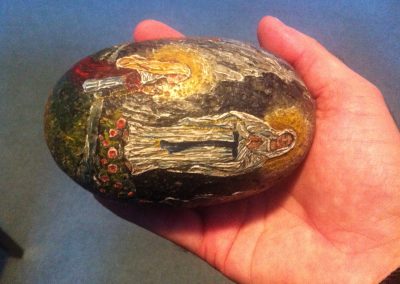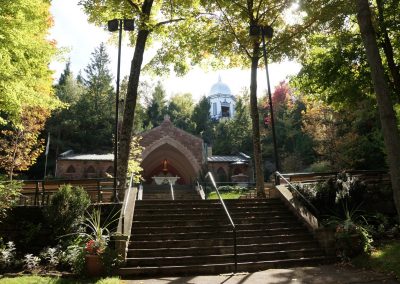Le sanctuaire de Rigaud et les pommes de terre changées en pierres
Le miracle des pommes de terre changées en pierres:
À Rigaud, il y a bien longtemps, vivaient quelques paysans, travaillants et croyants. Chacun vivait en toute tranquillité selon les saisons, cultivant la terre en été, faisant des provisions de bois de chauffage à l’automne en prévision de l’hiver.
Un jour, arriva un étranger venu s’établir au village. Ce dernier était peu bavard. Personne ne savait d’où il venait. On ne lui connaissait pas de famille ou d’amis. Il avait l’air mystérieux et l’on s’en méfiait. Ceux qui l’interrogeaient n’obtenaient aucune réponse et se faisait rabrouer vertement. Il ne tolérait pas d’intrusion dans sa vie privée. Il n’avait visiblement pas envie de raconter sa vie en détail. Il n’allait jamais à l’église.
Il n’en fallait pas plus pour éveiller la curiosité des paysans de Rigaud. Des histoires se mirent à circuler à son sujet. Les mères de famille faisaient peur aux enfants pour les empêcher de sortir le soir. On le surnomma José-le-Diable. Il prit vite la place du « Bonhomme Sept-heures ».
Un dimanche, on l’aperçut se rendant vers ses guérets (champs à labourer), au lieu de se rendre à la messe dominical. Du jamais vu ! On eut beau l’avertir, même le curé du village s’en mêla, mais il préférait bêcher son champ de pommes de terre. Pour José-le-Diable, aller à la messe était une perte de temps.
Sans attendre de réponse, José-le-Diable continuait son chemin.
Moi, aujourd’hui, il faut que je travaille…
Au moment où il arriva à son champ, son attelage s’arrêta net. Les cloches de l’église se mirent à sonner comme pour lui envoyer un message. Il se mit à semer son champ mais il ne se sentait pas très à l’aise. Il avait toujours en tête les paroles des paysans et celles du curé. Pour se donner du courage et oublier ces paroles, il se mit à blasphémer et à jurer. C’est alors que des milliers de cailloux tombèrent du ciel sur José-le-Diable et sur son champ.
Certains racontèrent que les pommes de terre se changèrent en pierres; ce qui expliquerait pourquoi plusieurs de ces pierres ont la forme d’une pomme de terre. D’autres dirent que l’homme a mystérieusement disparu, comme si la terre l’avait englouti. Pendant très longtemps, plus personne n’osa s’aventurer dans le champ de José-le-Diable.

Ces cailloux existent encore aujourd’hui. Ils sont un témoignage qui rappelle qu’on ne doit pas travailler le dimanche. Ceux qui ressemblent le plus à une pomme de terre furent répandus à travers le pays. Des religieuses ont même peint Notre-Dame-de-Lourdes sur un côté de certains cailloux.
Le Sanctuaire de Notre-Dame-de-Lourdes:
« Seize ans seulement après les apparitions de la Vierge à Bernadette Soubirous, Notre-Dame-de-Lourdes a commencé à être honorée à Rigaud. Cette dévotion à Marie, qui attire aujourd’hui plus de 100 000 personnes annuellement, est due à l’initiative d’un modeste religieux, le frère Ludger Pauzé des Clercs de Saint-Viateur. Ce dernier, en 1874, construisit une niche en haut d’un rocher sauvage difficilement accessible et y plaça une statuette de Notre-Dame de Lourdes. L’automne suivant, accompagné de ses élèves, le directeur du collège de Rigaud, le père François-Xavier Chouinard, c.s.v., transporta en procession à travers bois la statuette qu’il logea au flanc du rocher actuel, plus accessible. L’année suivante, une imposante madone était hissée sur le même rocher. La petite chapelle actuelle fut construite en 1887 et le premier pèlerinage d’envergure, marquant l’inauguration du sanctuaire, eut lieu la même année.
Dès son origine, la montagne de Rigaud est fréquentée par des pèlerins des environs qui viennent prier la « Dame en blanc » apparue à la petite bergère de France. Et comme à Lourdes, très tôt, on a pu constater que des faveurs obtenues tenaient du merveilleux. En 1890, par exemple, une paraplégique, Madame Séguin, fut miraculeusement guérie. Son mari, en reconnaissance, construisit l’autel qui s’y trouve aujourd’hui.
Une statue de l’Immaculée Conception, datant de 1882, est conservée dans la chapelle primitive. On peut admirer dans la sacristie un calice, également de 1882, ayant appartenu au père François-Xavier Chouinard ».
Sources:
Note : Étant donné qu’il ne semble pas y avoir de documents officiels racontant cette histoire des pommes de terre changées en pierres, il est difficile de situer en quelle année elle eut lieu. Mais nous estimons qu’elle a probablement eu au 19e siècle, époque oû la culture de la pomme de terre connut un grand essor au Canada.
Pèlerinages et lieux de prière au Québec, par Gilles Leblanc, page 79





